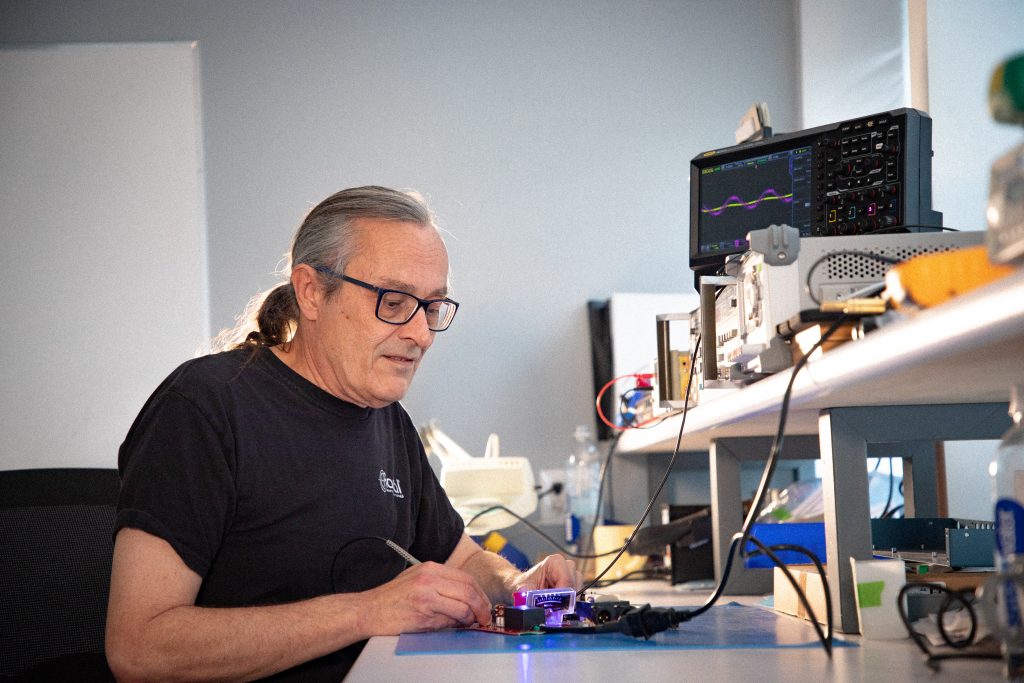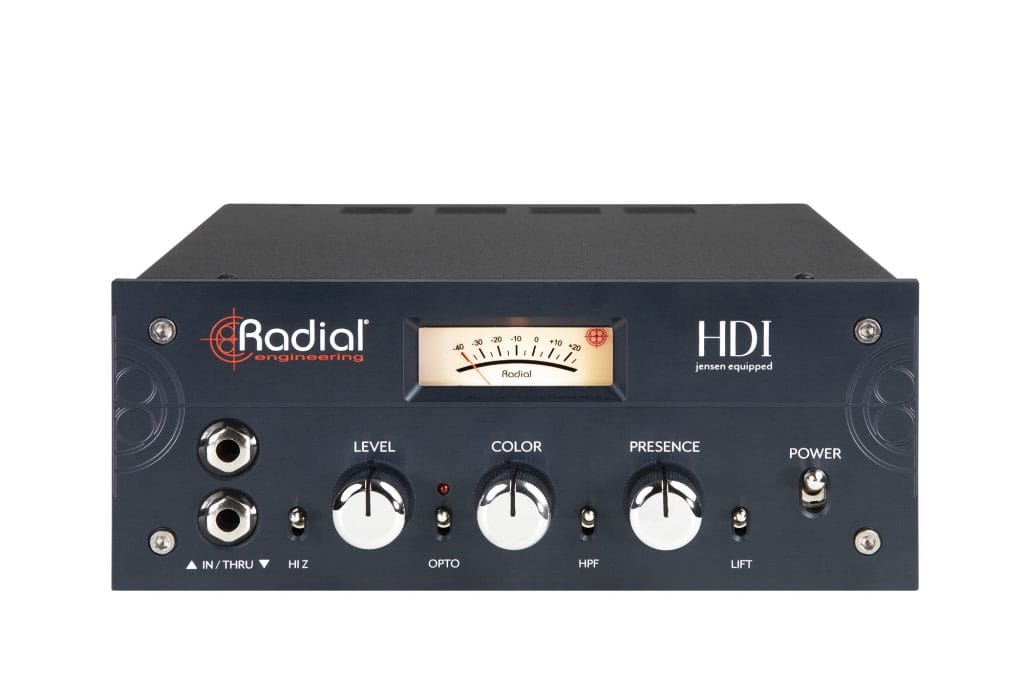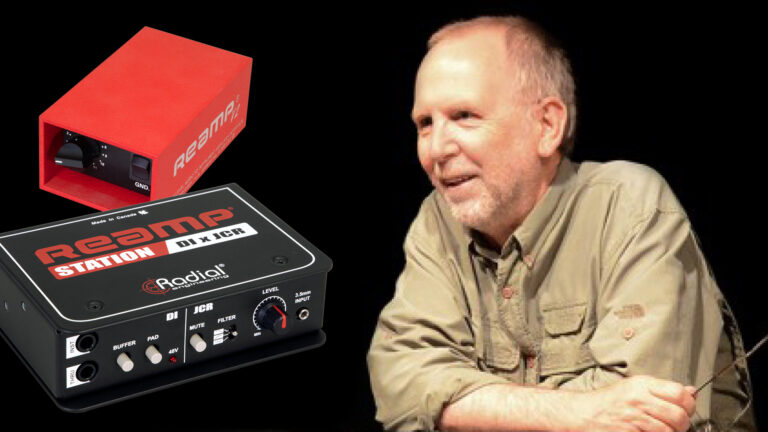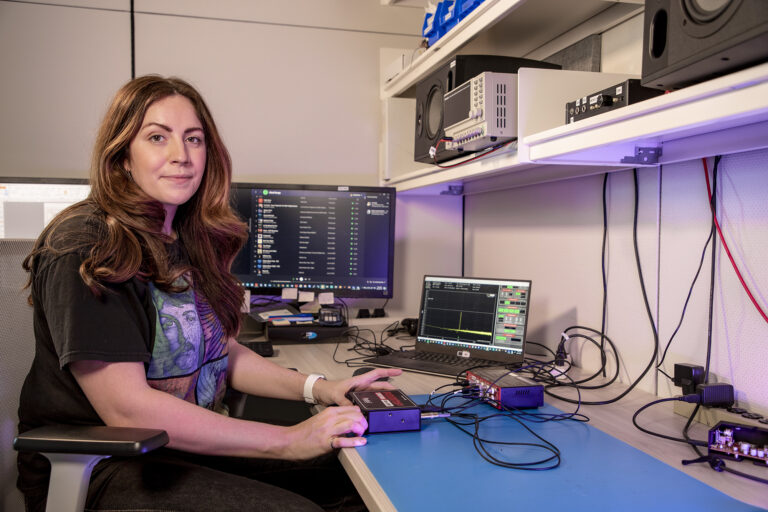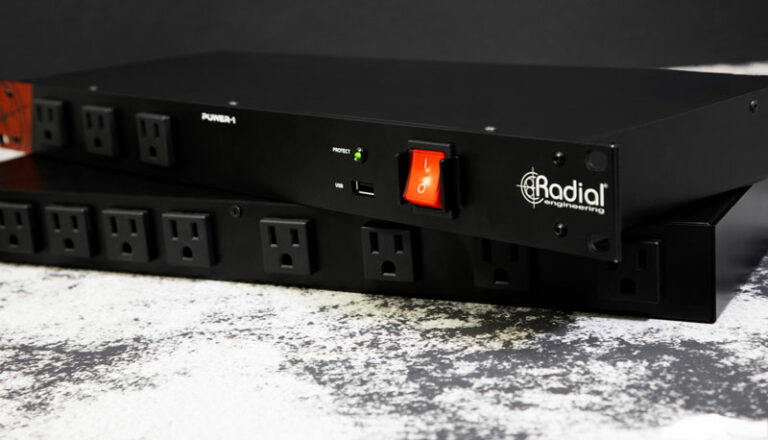This is an interview with Radial Engineering’s lead designer, W.C. “Hutch” Hutchison on his vision and design philosophy behind Radial’s unique new DI box, the HDI.
Share a bit about your vision for the HDI and how that fits in the context of Radial’s legacy in direct box design.
Radial has developed a reputation over the years for designing and building the best direct boxes. That said, virtually all direct boxes are what you might call utility boxes. They have a quarter-inch input and an XLR output and virtually no controls, other than maybe a ground lift or something like that. With the HDI, I want it to go beyond that basic utility functionality, while retaining the essence of the function of a DI. I wanted something that was more creative, fun, inspiring, and musical.
So how does the HDI differ in this regard?
The HDI is unlike other DI boxes on the market, in that, one goal was to introduce color, character, and distortion into the signal chain … particularly transformer distortion into the unit.
What was the primary goal with this direction?
The goal was to elicit some of the vintage warmth, richness, and flavor typically associated with classic tube-based devices. To achieve this, we developed some tube simulation circuits plus we had a custom transformer built by Jensen.
So the HDI uses a proprietary Jensen design?
Yes. This transformer gave the HDI an extremely wide range of transformer related character once we added other circuits around it. It can be much cleaner than a typical transformer, however we push the transformer into a region where the tone is particularly colored. Let’s call it an exaggerated transformer.
What would you say to the purists who claim that a direct box should be a pure, basic utility box, with no other bells and whistles?
Well, I can’t argue with the purists. But in respect to this, there is a Color knob on the HDI. And in the fully counter-clockwise position, you get a clean and pure audio signal, probably cleaner than any other existing direct boxes. So in terms of addressing the “purist” question, the HDI probably does purist better than most. It is no slouch in the realm of “fidelity”.
But by turning the Color control, things begin to happen, correct?
Yes, the Color control can be turned clockwise to add color. So, the HDI does achieve quite a wide range from ultra-clean at fully counter-clockwise to a generic amp simulation effect as you turn the knob clockwise.
What exactly is happening signal chain-wise when the Color knob gets turned?
That’s where it gets complicated! The HDI has four parallel circuits inside it. There’s a Color knob and a Presence control. These two knobs determine the blend of the four circuits. The Clean Mode with Presence control turned all the way towards flat is exactly that … flat and clean and as true as we could make it. As you turn the knob towards more color, a bunch of things happen. For one, we force a little bit more even harmonic distortion in the transformer itself.
What does that do?
As you go lower in frequency and louder in level, transformers tend to add distortion. And because of the combination of those two factors, they have characteristic transformer distortion that people are used to and often associate with the vintage sound, such as with the sixties or seventies kind of tone that people are often striving for. So, we’re able to both reduce the transformer character in our circuits and exaggerate it depending on where a user sets their controls. Sonically, what it seems to do, probably the strongest effect, is it seems to add low mids. Basically, that’s the harmonics of the lows, generally perceived as low mids.
And what does that do to the tone? Does that give it a warmer tone?
Yes, warmer, richer, thicker. A long time ago, I worked for a company that made tube gear. As our products became popular, all of a sudden tons of other companies started coming out with tube gear. And every second ad that you saw claimed their tube-based device made the tone “warm.” In a tech talk I did many, many years ago, I said, “…it’s not the tubes.” Tubes are basically pretty clean and have been used in hi-fi and mastering gear. Typically, it’s the transformers that often provide some warmth, and often it’s the combination that really works well. That said, the better transformers tend to also be pretty transparent, which is where the circuits around the transformer can be designed to increase or reduce inherent colors. Much of the magic with tubes is how they sound when pushed near clipping and, in instrument amps, well into clipping.
Talk more about the circuits incorporated in the HDI.
There are four parallel circuits in the HDI. One is particularly clean and flat. A second one is with the Presence control turned up but it’s still clean and that adds a special EQ curve. This simulates tonal qualities of cleanish guitar amps. So turning up the Presence control gives it an immediate guitar amp quality, but still clean. The third circuit simulates the sound with the color up and that brings in a discrete circuit that’s set up like the topology of an old triode guitar amp phase splitter. And the idea here is to introduce some familiar distortion characteristics, tones that are immediately familiar. There is also pre-emphasis in this color circuit and then de-emphasis is with the Presence control set at “flat”. In other words, it boosts highs and then cuts highs. The tone tank of a guitar amp typically boosts a lot of highs. The de-emphasis or cutting highs section, more or less approximates a 12-inch speaker, similar to what you find in most guitar amps. As you turn the presence control up you get less and less of that speaker effect and you get a brighter sound.
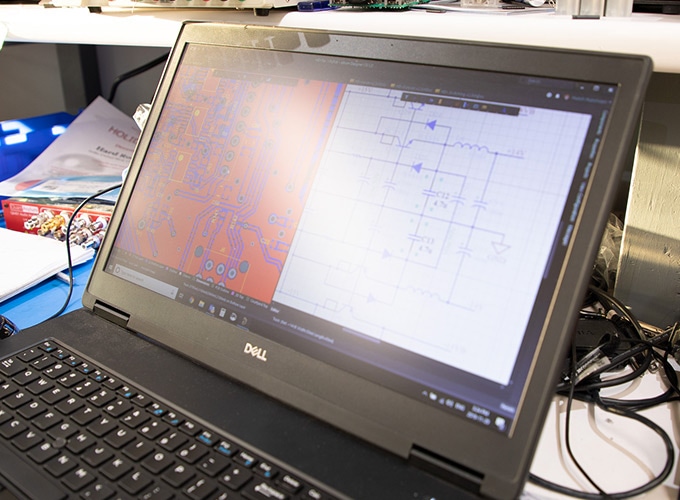
So in essence, the HDI incorporates very complex technology under the hood, but the user interface and control is basically simple and elegant, correct?
Yes, all of this under the hood technology is a bit complicated electronically but in reality, there’s just a Gain control, Color control and a Presence control. And anybody can sit with the HDI and in 10 or 15 seconds dial up an inspiring sound. So technically and from an engineering standpoint, the HDI might be deep, but for the user it’s real simple. The end goal is to inspire the player. Sound and simplicity shouldn’t be underestimated.
What type of instruments does the HDI work best with?
It works great for bass, works great for keyboards, works great for guitar. Basically anything with a quarter inch jack will be enhanced by the HDI. It even has a 3.5 mm jack intended for musicians with modular synths.
Talk about the Distortion characteristic of the HDI.
Most guitar players are used to playing through amplifiers and there’s a certain feel or dynamic that comes with playing into an amplifier in terms of how hard a player picks, how they ride the volume control, those kinds of things. So the distortion had to work in a way that they are familiar with.
Is this related to the transformer?
The transformer is part of it, as well as the discrete circuits simulating tubes, as well as the pre-emphasis and de-emphasis, boosting the highs before the distortion and rolling off the highs after the distortion.
And what effect does that have?
Rolling off the highs after the distortion obviously reduces some of the buzzy and nasty harshness that you find in a typical $100 fuzzbox. In this way, it’s just using a similar topology to that of a vintage guitar amp. In many instrument amps the last stage is typically the one that distorts first and then the stage before that distorts when you increase the volume a little bit more. And the first distorts once you turn on the gain up a little bit more or play harder so that even when all three stages are distorting, they’re all sharing some of the burden. So it’s not just one stage clipping, so to speak. And that’s kind of how you get to the range of it starting kind of slow or gentle and gradually getting more aggressive. It’s not instantly aggressive, it’s a gradual thing.
What makes it different in terms of the way it’s doing the distortion
For the distortion quality, we are using proprietary Radial discrete circuits that emulate tubes, and this proprietary approach to creating distortion is one component of the HDI that helps really set the unit apart from everything else out there.
Why did you take this approach?
Well, there is no point in doing the same thing that everybody else has done forever and ever. The point here was making the HDI different, but by different, also better, more usable, more playable, more fun. Certainly more creative. In other words, simply being able to plug in and have an immediately good sound should make everybody in the room smile. The tricks that this box does for an engineer, a recording engineer, they would need a pretty serious chain of plugins or processors, a couple of EQs, a compressor, a couple of distortion devices, all in the right kind of a series parallel arrangement. It wouldn’t be so easy! So this does all that quickly and simply and without the user really needing to know what’s going on under the hood.
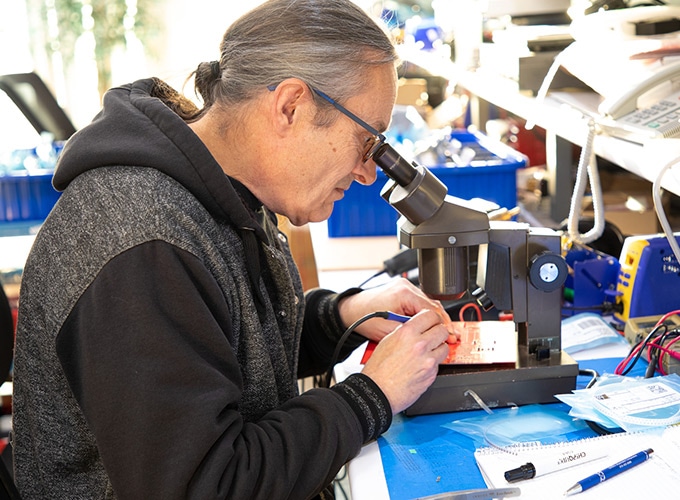
Talk a little more about the purpose of the transformer in a direct box such as the HDI.
If you have a transformer it’s probably going to add color, and that goes for any transformer based direct box, however the effect ranges from very subtle to significant and sometimes not very pleasant. In the case of the HDI, we have the transformer and it does add subtle color, but we also have a circuit in there that reduces that color or increases the color. So it can be cleaner than a typical transformer direct box but also, when increasing color, that it does it in a musically pleasing way. It helps to use Jensen transformers.
And Jensen is considered the state-of-the-art provider of transformers for a device like this?
Yes. I think the Jensen standard direct box transformer is truly the best that’s made. We don’t use the standard Jensen transformer for the Color circuits. We use one of the top of the line Jensen transformers in the HDI to drive the Mic level output, but in terms of getting color and reducing color, we have a specially designed Jensen transformer that was tailor made for the HDI.
Share more about the opto-compressor in the HDI.
The opto has several purposes. First, it gives some added protection so that if the player does some aggressive thumb slapping on the bass or that kind of thing, it holds levels back a bit and can keep signal levels from going over the top. A bit of a gift for the mix engineers. It can also get kind of funky and fun to play into which is a gift to the musicians. It also helps maintain the apparent relative loudness between the clean and color circuits once the color circuit is driven well into distortion.
Meaning there’s not a lot of tweaking required to get a great tone?
Yes, there’s not a lot of knobs. It’s basically gain and threshold or input and output gain depending on the design. Essentially fixed attack and release times, fixed ratios, etc. It’s the simplicity and elegance of it that’s really the magic. And so the Opto feature in the HDI is another one that follows that theme. It’s just simple basic fixed attack and release, fixed ratio but carefully chosen. The Opto works on the clean channel in this box. The driving force behind that is that as you turn up the gain, in the Color channel, the signal can get clipped so that channel sounds a somewhat quieter compared to the Clean channel and the opto compensates.
How would you describe the goal of the opto compressor in the HDI?
The opto has two purposes. One is to keep that balance between clean and colored still smooth. So as you change that knob it doesn’t change level. And the other is just to offer a little bit of added protection so that if somebody does some thumb slapping on the bass or that kind of thing, it holds it back a little bit and doesn’t freak out the engineer or the audience. The opto is a useful thing that adds a little bit of a control, but it also adds a little bit of nice funkiness to the tone.
Could the HDI essentially simplify a setup, such as a guitar player needed less pedals and effects?
Yeah, I would expect some people to do that. And I would expect other people to do exactly the opposite. For example, there’s a lot of people using digital amp simulators like the Kemper. And we’ve found that this thing works really nicely after a Kemper, and it works really nicely before one sometimes. Some of the newer amp simulators do a wonderful job, but it’s not quite analog tube-like exactly. The HDI seems to bring some of the analog back into the path, maybe sounding a bit less brittle.
What about the HDI’s usefulness at Front of House?
I think it certainly is going to help a lot of front of house engineers, especially in those situations where the DI mostly considered backup in case an amp fails. In that case, the HDI will give a much more immediately usable signal, much more amp-like. Maybe more importantly, it should blend easier with a miked-up amp signal for those that blend amp and DI. And even on its own, as the only signal, the sound quality will likely be far better than what they were using.
What are some other potential uses of the HDI?
On stage, it gives arm’s length control for musicians that depend on monitors rather than amps. We anticipate that the HDI may become the go-to DI in recording studios, the next standard for studio gear. My background is in world-class studios so this DI had to fit in that picture. In fact, most of the circuits would qualify as being mastering equipment quality and were developed for high end mastering. Of course, the HDI is still affordable for project studios and is a good way to get some amp flavor without needing to set up an amp and dealing with the loudness. Basically, a truly better alternative to a standard DI for recording.
How did you design the HDI to be as low-noise as possible?
We did this in three ways. Where there’s op amps in the path, we’re using some of the lowest noise, lowest distortion parts available. In fact, the input op-amp that we use is the lowest distortion op-amp made at this point in time. The second way is keeping the power supply very quiet and we use a pretty new circuit there to filter as much noise as possible so that the power supply rails are ridiculously quiet. The third way is attention to board layout and making sure the sensitive bits are distanced from the noisy bits. That’s just careful layout, best design practices, that kind of thing.
How long was the HDI in development before it became a reality?
It was probably four months initially to get a good working prototype that I could demonstrate to other people. And there’s been a couple more months on top of that for a second prototype and production ready unit. And some of that is basic R & D, checking out little sub-circuits ideas and concepts. Another part is the real schematic and board layout — putting parts in and seeing how it works in a real environment. Part of it is just refining and listening. I do a lot of listening and adjusting by ear. It’s like mixing. You can’t just do it by numbers. You have to do it by listening and tweaking. Where a recording engineer might be twisting knobs and pushing buttons, I’m choosing parts and adjusting values, selecting circuits. It’s basically the same approach, just a different level of our audio technology.
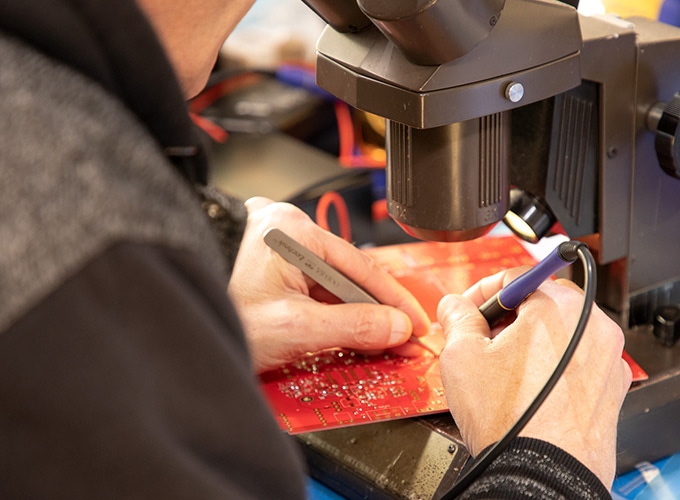
What type of testing did the HDI go through before final design?
We have a number of good guitar players and bass players at Radial. And initially it was just the closest player around for the first tests. But as we got to the really decent first prototype we invited everybody in and had several bass players and several like guitar players and we tried all the keyboards in the studio. We just spent two or three days just messing around and seeing what it could do. One of the first reactions was one of the guys here plugged in a bass, and we both kind of looked at each other, and it was like, who needs an SVT? It was THAT kind of a sound immediately. And that’s off a couple of little studio bookshelf speakers. But it was that kind of room-filling sound that you associate with a big SVT stack or even a double stack. It was huge. We have a, a nicely equipped studio right next door to the design lab and we certainly have a lot of musicians here in the building. And some of them are actively performing weekend guys, you know, who are really quite talented. So it’s fun, and I love getting everybody’s opinions, ideas, thoughts and questions.
Is it fair to say that there’s, there’s not really any other manufacturer, especially in this class that’s focused on the level of quality and design with direct boxes in the way that Radial Engineering is?
Radial is the leading manufacturer of direct boxes and we have a rather wide range. I don’t see anybody else doing the type of design we’re doing with the HDI. As I originally said, most direct boxes are kind of boring utility devices. The HDI is different. This is almost a unique product category than that of a traditional direct box. It does so much more. It’s still a direct box technically, but it’s a lot more than a direct box from the musician and engineer’s standpoint. I don’t see any companies actually taking this type of approach with direct box design. It’s like a cross between a direct box, a preamp, and a vintage amp simulator. It really is different.
Sign up for updates for more info about the HDI here:

